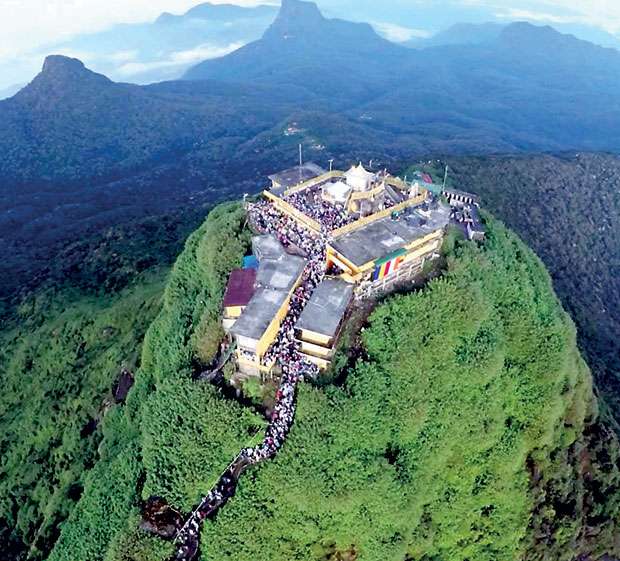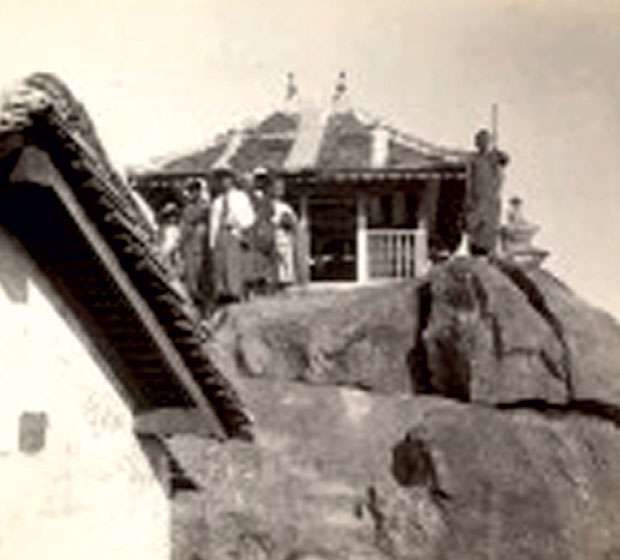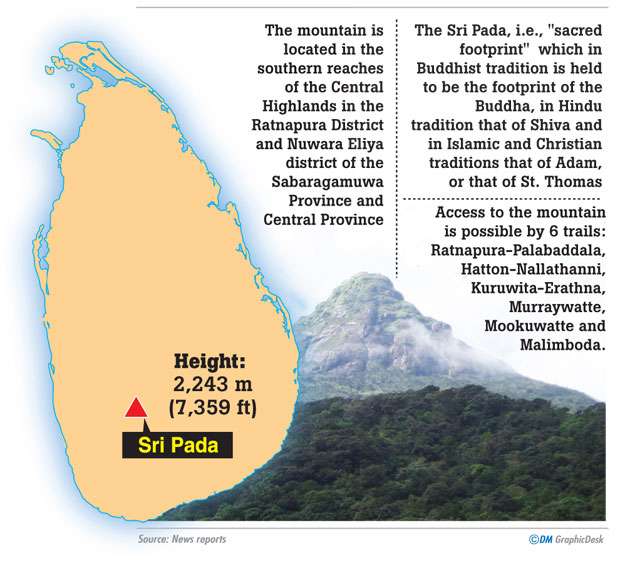Reply To:
Name - Reply Comment

As the Sri Pada pilgrimage season is on, a look at some historical facts behind the sacred ritual
The season of climbing Samanalakanda, Adam’s Peak or Sri Pada begins with Unduvap Poya on Saturday and ends on the Vesak Poya.
The belief of Buddhists is that Buddha on his third visit to Sri Lanka kept his footprint at the bequest of God Saman.
Various religious groups claim that it was the footprint of their leader. Portuguese believed that the footprint was that of St. Thomas or that of Queen of Ethiopia.
Lt. Malcolm is believed to have ascended the mountain in 1816 but, Tennent says that he climbed the mountain on April 27, 1827.
Now, which is correct? But he had made measurements of the area where the Sacred footprint is situated.
He records that the entire area is 1,777 square feet. The length of that area is 74 feet and it is 24 feet in breadth.
It is recorded by him, that there is a huge boulder about eight feet high, which, according to him is said to have the Sacred Buddha’s footprint.
He says:
“Atop which is found the Sacred foot mark. According to mythical conception woven of folklore, the real impression of the foot lies under the boulder, on a blue sapphire. To prevent it from sacrilegious profanation, God Sakra, it is said had it covered with a boulder. “
Dr John Davy, who had also climbed the mountain says
“The foot mark is a superficial flow 68 inches long and 31 inches and 29 inches wide at the toes and the heel respectively. It is ornamented with a margin of brass and studded with a few gems. The cavity bears some coarse resemblance to a human foot, but the size is gigantic and seems partly natural and partly artificial. There are little-raised portions to represent the intersection between the toes.”
"but the size is gigantic and seems partly natural and partly artificial. There are little-raised portions to represent the intersection between the toes"
I, as a child of six or seven years, was taken to climb Sri Pada or Samanalakanda. But, the weather was so bad that I could not climb from the point of Indikatupana.
In passing my grandmother initiated me to a number of Buddhist sites during her lifetime and she was a wealth of information. So, I was left with an aide at Indikatupana and she made her way to the top of the hill.
She only came down in the morning, having seen the rising of the sun and the shadow of Adam’s Peak. During this period I was offered coffee from those boutiques set up for this purpose.
It took another decade for me to decide to climb this sacred mountain which rises to 7,359 feet.
That was the time one should have visited this internationally famous shrine claimed by people of various religions as that of their own leaders.
Today so much has been added, with all faith, but the serenity and the virgin and humble rock have been made Gaudy to my thinking. May it be so, but the faith has not been given away to climb this sacred mountain, by kings and commoners.
Even from times immemorial, the last lap of the climb is aided by iron chains and stanchions, but who erected them is unrecorded.
Commenting on this, Robert Percival who served with the British Garrison has noted thus:
“The iron chains on the rock of Adam’s Peak have the appearance of being planted there at a very early date, who placed them and or for what purpose is unknown. They were set up, according to most observers by a mystic force.”
Whatever it is, all evidence indicates that the sacred peak was in the limelight long before the recorded history of the country.
There are a number of thoughts, some say that Portuguese called it Adam’s Peak, but yet others believe that it was a Moor-man who called it Adam’s Peak. These are referred to in Tennent and Davy’s Ceylon.
"That was the time one should have visited this internationally famous shrine claimed by people of various religions as that of their own leaders"
But for many of us, it is Samanalakanda. There was a time when we used to see thousands of white Butterflies making their way towards Samanalakanda, which the old folk used to say that they went towards the high mountain and die there.
Perhaps the commonly called name Samanalakanda could have been derived from this scene of butterflies, that flew towards the sacred peak.
Rashtrapati Privenadipathi Kirielle Gnanawimala Thera says in his writings that Kirthi Sri Rajasinghe, Nissankamalla, Maha Parakrama Bahu, Parakrama Bahu I and II, and many other Kings had worshipped at the sacred mountain at one time or other.
The Thera points out that this is inscribed in a stone inscription at the foot of the climb, but the Thera adds that the inscription is defaced due to devotees burning copra at this point before they climb the last lap to the mountain.
According to Tennent, a Venetian Nicolo de Cante, who had climbed the mountain said that the footprint was not that of Adam, but he did not say either how he had come to this conclusion.
Much had been said about Sri Pada and according to sources, the footprint is not where we are supposed to think it is.
It is said that the footprint is on a Blue Sapphire underneath the present location.
William Sheen points out that there was a cavity on the side of the original rock formation which could be seen and he thinks that the footprint could be there on a Blue Sapphire.
Perhaps it is so and could be so.

It is not possible that Gautama the Buddha would have left his footprint on an empty rock formation and that God Saman would never have let him do so on a raw rock formation, when there are so many gems and minerals around the area.
According to Rajavaliya, Parakrama Bahu I visited this sacred mountain and ordered the building of a temple possibly in the 18th Century.
Parakrama Bahu II after his climb granted 20 miles of land around Samanalakanda for the benefit of the devotees.
Later on, some ascetics from India visited villages around the mountain and went from village to village collecting money to build steps to the peak of Samanalakanda.
They in fact constructed steps for the welfare of those devotees visiting the sacred mountain. These ascetics could be the generation of ascetics, who are believed to have been placed by Rajasinghe I of Sitavaka to be in-charge of this sacred mountain.
"Even from times immemorial, the last lap of the climb is aided by iron chains and stanchions, but who erected them is unrecorded"
According to Chulavamsa King, Wimaldhramsuriya II worshipped at Sri Pada and stayed there for seven days and offered an umbrella of silver to be over the footprint.
The belief of the Muslim community is based on the old testament and they call it Adam Malai due to the belief that the sepulchre of Adam lies on the top of the sacred mountain.
Hindus believe that it is the footmark of God Shiva. It is believed by Hindus that God Shiva had settled to remain on this summit for the sake of mankind. Hence they have coined the word “Sivanolipadam.”
However, things have changed and more comfortable forms are made to climb the sacred mountain with the dawn of the season.
The authorities today take the statue of God Saman, the white elephant and other sacred objects, from Galpottawela Raja Maha Vihara at Pelmadulla built by King Kirti Sri Rajasinghe. But, they have not forgotten to stop at Maha Saman Devale in Ratnapura, where a ritual is conducted so that the season for the devotees would be free from any mishaps.
"Hindus believe that it is the footmark of God Shiva. It is believed by Hindus that God Shiva had settled to remain on this summit for the sake of mankind"
The two historic paths to the summit of the sacred mountain are through Hatton and Ratnapura through Kuruwita.
There is an instance recorded by John Still in his book Jungle Tide, where he points out how a group of pilgrims fell into the precipice below in the last phase of the climb while holding on to a loose chain.
The large lamp atop the mountain was an offering of King Wickramabahu, which burns day and night. Devotees think the oil of this lamp is powerful and for their own good. This lamp seems to have been replaced in 2014 according to news reports. Has it anything to do with the climatic change and changes.
